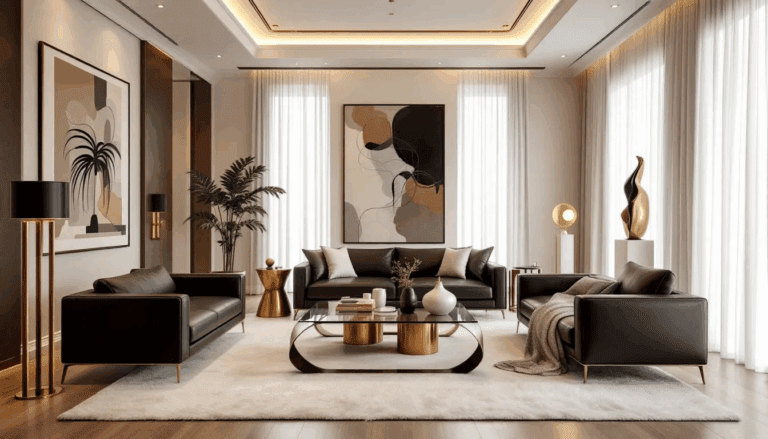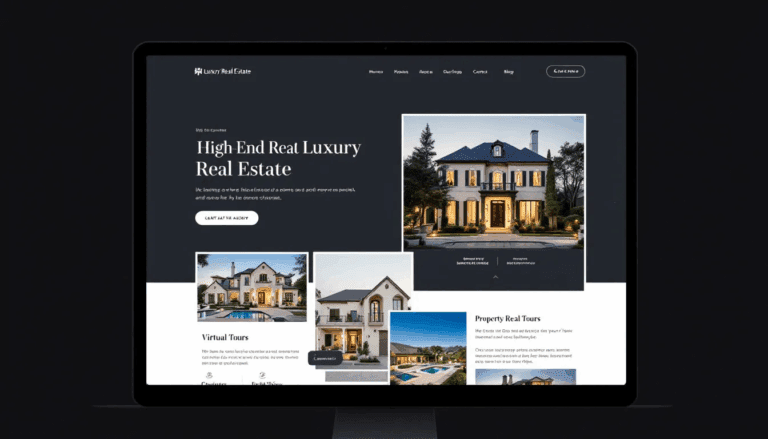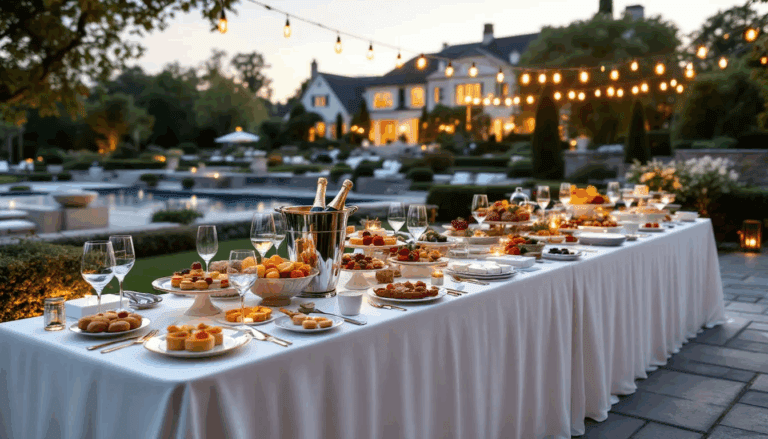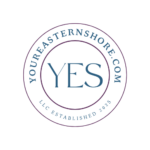Key Takeaways
- Luxury listings require 3-5x higher marketing budgets, typically $5,000-$15,000 vs $1,000-$3,000 for mid-range properties
- Professional staging and architectural photography become essential investments for million-dollar properties, often costing $5,000-$15,000 combined
- Target audience shifts from local buyers to international investors and high-net-worth individuals requiring specialized marketing channels
- Digital marketing expands from basic MLS listings to luxury real estate platforms like Mansion Global, Wall Street Journal, and Robb Report
- Marketing timeline extends from 30-60 days to 90-180 days, requiring sustained premium marketing campaigns
The difference between marketing a $500,000 property and a million-dollar listing isn’t just about spending more money—it’s about fundamentally shifting the entire sales process and understanding what separates luxury buyers from typical homebuyers. While many salespeople assume that the same marketing strategies can be scaled up with bigger budgets, the real value lies in recognizing that affluent customers have completely different expectations, decision-making processes, and channels where they discover properties.
The wrong answer is thinking that a larger advertising spend alone will attract seven figures buyers. The right answer involves a deeper analysis of how luxury marketing creates an aspirational experience that justifies premium pricing. This comprehensive guide will examine the specific marketing investments, strategies, and tactics that successful agents use to bridge the gap between mid-market and luxury real estate sales.
Understanding what kind of marketing separates a $500k listing from a $1M one requires examining not just the financial investment, but the strategic shift in positioning, presentation, and buyer psychology that luxury properties demand.
The Marketing Investment Gap Between Mid-Range and Luxury Listings
The most significant difference between marketing a $500k property versus a million-dollar listing lies in the substantial investment gap that reflects the different buyer expectations and market dynamics. This isn’t simply about spending more money—it’s about understanding that the business model for a company operating in luxury real estate is influenced by company strategy and operates on entirely different principles than mid-market properties. As previously discussed, these differences shape every aspect of the marketing approach.
Mid-range properties typically allocate 0.5-1% of the listing price to marketing, resulting in budgets ranging from $2,500 to $5,000. For example, a $500k property might have a $2,500 marketing budget, while a $750k property could allocate $5,000. These budgets focus on essential marketing activities: professional photography, basic staging consultation, MLS distribution, and modest social media advertising. The sales process for these properties emphasizes quick turnover, with most transactions completing within 30-45 days. These are just a few examples of how marketing spend and strategy differ at various price points.

Luxury properties demand a fundamentally different approach, with marketing investments typically ranging from 1-1.5% of the listing price. For a $1M property, this translates to $10,000-$15,000 in marketing spend, while ultra-luxury properties may justify even higher percentages. This substantial investment reflects the reality that luxury buyers expect an experience that matches their net worth and lifestyle expectations, and they are looking for values that go beyond price—such as exclusivity, privacy, and a unique lifestyle offering. It makes sense to invest more in marketing for these listings, as the potential return and the expectations of the clientele are significantly higher.
The ROI justification for these higher marketing investments becomes clear when examining the commission structure. A $500k sale generates approximately $15,000-$30,000 in total commission (split between listing and buyer agents’ accounts), while a $1M sale produces $30,000-$60,000. This higher commission base supports the premium marketing investments that luxury properties require to attract qualified buyers and achieve fair price realization. The way commissions are split between different accounts or agents can also influence the marketing resources allocated to each listing.
Timeline differences significantly impact marketing strategy and budget allocation. While $500k properties typically sell within 30-60 days, luxury properties average 90-180 days on the market. This extended timeline necessitates sustained marketing campaigns, multiple promotional phases, and ongoing relationship nurturing that requires both time and money to execute effectively. As discussed, agents must consider other ways to maintain buyer interest and engagement, such as exclusive events, targeted outreach, and leveraging high-value networks, not just increasing the marketing budget.
The competition analysis reveals another crucial factor: luxury markets have fewer but more discerning buyers. Unlike mid-market properties where buyers may compromise on certain features due to budget constraints, luxury buyers have the financial capacity to wait for properties that meet their specific requirements. This buyer behavior demands marketing that demonstrates value beyond mere square footage or location convenience, and ultimately influences the outcome of the deal. The strategies discussed here highlight the importance of understanding both tangible and intangible values when positioning a luxury property for sale.
Visual Marketing: Photography and Staging Differences
Visual presentation represents perhaps the most dramatic difference in what kind of marketing separates a $500k listing from a $1M one. The investment in photography, staging, and video production scales exponentially with property value, reflecting the sophisticated visual standards that luxury buyers expect.
Photography budgets reveal stark differences between market segments. Mid-range properties typically invest $500-$1,500 in professional photography, covering basic interior and exterior shots with standard equipment. This budget usually includes 20-30 high-quality images suitable for MLS distribution and basic online marketing.
Luxury properties require comprehensive visual documentation that can cost $3,000-$8,000 or more. This investment includes architectural photography with specialized wide-angle lenses, drone footage for aerial perspectives, twilight photography to showcase exterior lighting, and detailed shots of custom features and finishes. Many luxury listings also include lifestyle photography showing how spaces can be used for entertaining or relaxation.
Professional staging costs represent another significant difference. For $500k homes, staging consultation or light staging might cost $2,000-$4,000 and is often considered optional. Many mid-market buyers can visualize how they’ll furnish spaces, making extensive staging less critical for sales success.

Luxury properties treat professional staging as an essential investment, typically spending $8,000-$20,000 to create aspirational lifestyle presentations. This staging goes beyond basic furniture placement to include designer pieces, original artwork, fresh flowers, and curated accessories that help buyers envision the sophisticated lifestyle the property enables. The staging often tells a story about how the space enhances entertaining, relaxation, or daily living in ways that justify the premium price point.
Video content production shows similar scaling. Mid-range properties might include basic walkthrough videos shot with smartphones or entry-level equipment, focusing on showing room layouts and basic features. These videos typically cost $500-$1,500 to produce.
Million-dollar listings demand cinematic video productions that can cost $3,000-$10,000. These productions include professional crews, multiple camera angles, drone footage, and sophisticated editing that creates an emotional connection with potential buyers. The videos often incorporate lifestyle elements, neighborhood amenities, and architectural details that position the property as more than just a house—but as a lifestyle choice.
Virtual tour technology also differs significantly between price points. Mid-range properties typically use standard 360-degree tours that allow buyers to navigate through spaces online. Luxury properties increasingly invest in immersive VR experiences, interactive floor plans, and augmented reality features that allow potential buyers to visualize custom modifications or furniture arrangements.
Print quality standards reflect these different expectations. While mid-range properties use standard MLS photography that looks good on computer screens, luxury properties require magazine-quality images suitable for high-end publications, custom brochures, and large-format displays at exclusive events.
Digital Marketing Strategies That Scale with Price Point
The digital marketing landscape for luxury real estate extends far beyond the standard platforms and strategies used for mid-market properties. Understanding what kind of marketing separates a $500k listing from a $1M one requires recognizing that affluent buyers discover properties through entirely different online channels and expect sophisticated digital experiences.
MLS distribution represents the foundation for all properties, but luxury listings require access to specialized networks. While $500k properties rely primarily on local MLS systems and broad consumer sites, million-dollar listings need distribution through luxury-specific networks like Leading Real Estate Companies, Luxury Portfolio International, and Who’s Who in Luxury Real Estate. These networks provide access to international buyers and high-net-worth individuals who don’t typically browse standard real estate websites.
Website presence differs dramatically between market segments. Mid-range properties typically appear as listings on agent websites alongside many other properties. Luxury listings often receive dedicated property websites with custom domains, professional copywriting, and immersive multimedia presentations. These microsites serve as digital brochures that can be shared with qualified prospects and provide detailed information about the property, neighborhood, and lifestyle opportunities.

Social media advertising budgets reflect the different customer acquisition costs for each market segment. Mid-range properties might allocate $500-$2,000 to Facebook and Instagram advertising, targeting local buyers within specific demographic ranges. The focus remains on reaching the maximum number of potential buyers within budget constraints.
Luxury property social media campaigns require $5,000-$15,000 budgets spread across multiple platforms including LinkedIn, YouTube, and specialized luxury lifestyle publications. These campaigns use sophisticated targeting based on income levels, interests in luxury goods, and geographic parameters that include international markets. The content quality must match luxury brand standards, with professional photography and video content that reflects the sophisticated tastes of the target audience.
SEO strategy becomes increasingly important for luxury properties due to the longer sales cycles and research-intensive buying process. While mid-range properties focus on basic listing optimization, luxury properties benefit from comprehensive content marketing that includes neighborhood lifestyle guides, architectural features explanations, and luxury amenities descriptions. This content helps establish authority and captures buyers during extended research phases.
Email marketing approaches also differ significantly. Mid-range properties typically use broad buyer databases and standard templates to announce new listings. Luxury properties require curated communications sent to carefully selected high-net-worth individual lists, international buyer networks, and luxury lifestyle service providers who serve as referral sources.
Platform Selection and Reach
The digital platforms used for luxury marketing extend far beyond traditional real estate websites. While mid-range properties focus on Zillow, Realtor.com, local MLS portals, and Facebook Marketplace, luxury properties require presence on specialized platforms that cater to affluent buyers.
Luxury-specific platforms include Sotheby’s International Realty, Christie’s International Real Estate, Mansion Global, Luxury Real Estate, and The Wall Street Journal’s mansion section. These platforms charge premium fees but provide access to qualified buyers who specifically seek high-end properties and expect the level of service that comes with luxury transactions.
International exposure becomes crucial for million-dollar properties, as many buyers come from overseas markets or represent international investment capital. This requires marketing presence in international publications, overseas real estate portals, and foreign-language materials for key markets like China, Canada, and European countries where buyers actively seek US real estate investments.
Niche platforms include luxury lifestyle magazines, private wealth management networks, and exclusive buyer clubs that serve ultra-high-net-worth individuals. These channels often require personal relationships and referrals to access, making networking and industry connections essential for successful luxury marketing.
Target Audience and Channel Selection
The buyer profiles for $500k versus $1M properties differ so dramatically that they require completely different marketing approaches, communication strategies, and relationship management processes. This fundamental shift in target audience represents a core aspect of what kind of marketing separates a $500k listing from a $1M one.
Mid-range property buyers typically include local professionals, growing families, first-time luxury buyers, and individuals seeking primary residences within commuting distance of their employment. These buyers focus on practical considerations like school districts, commute times, maintenance costs, and neighborhood safety. Their decision-making process often involves multiple family members and emphasizes value comparison with other properties in similar price ranges.
The sales process for these buyers typically spans 30-60 days from initial interest to closing. They rely heavily on online research, virtual tours, and comparison shopping before scheduling in-person visits. Price sensitivity remains a significant factor, and buyers often seek properties at the lower end of their approved budget to allow room for improvements or unexpected costs.
Million-dollar property buyers represent a fundamentally different demographic. These buyers include executives, entrepreneurs, international investors, second-home buyers, and downsizing affluent empty nesters who prioritize lifestyle, exclusivity, and status considerations alongside practical features. Their net worth allows them to focus on emotional and aspirational factors rather than purely financial calculations.

Geographic reach expands dramatically for luxury properties. While mid-range buyers typically search within local or regional markets, luxury buyers may relocate from anywhere in the world. This international reach requires marketing materials in multiple languages, familiarity with international buying processes, and relationships with overseas real estate professionals who can facilitate transactions.
Communication preferences differ significantly between these buyer segments. Mid-range buyers expect responsive email and phone communication, standardized processes, and efficient transaction management. Luxury buyers demand concierge-level service that includes personal relationship management, flexible scheduling around their business travel, and white-glove attention to detail that reflects their expectations based on other high-end service experiences.
Decision timelines extend considerably for luxury purchases. While mid-range buyers often make relatively quick decisions based on practical needs and budget constraints, luxury buyers may spend 6-18 months researching markets, comparing properties, and waiting for the perfect opportunity. This extended timeline requires sustained relationship building and ongoing communication that maintains engagement over months rather than weeks.
The decision-making process for luxury buyers often involves multiple stakeholders including family members, financial advisors, attorneys, and sometimes business partners. Marketing materials and presentations must address the concerns of sophisticated advisors who will conduct thorough due diligence on the investment aspects of the purchase.
Luxury Marketing Tactics for Million-Dollar Properties
Luxury real estate marketing employs exclusive tactics that would be impractical or unnecessary for mid-market properties. These strategies focus on creating experiences that match the sophisticated expectations of high-net-worth buyers and demonstrate the lifestyle value that justifies premium pricing.
Exclusive events represent a cornerstone of luxury marketing that simply doesn’t exist in the $500k market segment. Private showings, broker caravan tours, and invitation-only open houses create a sense of exclusivity that appeals to buyers who value discretion and personalized attention. These events often include catered refreshments, live music, and opportunities for buyers to experience the property in a social setting that demonstrates its entertaining potential.
Some luxury listings host themed events that showcase specific property features. Wine tastings in custom cellars, art exhibitions in gallery spaces, or chef demonstrations in gourmet kitchens help potential buyers envision how they might use these specialized spaces. The cost of these events, typically $2,000-$10,000, is justified by their effectiveness in creating emotional connections with serious buyers.
Lifestyle marketing extends beyond the property itself to encompass the entire living experience. Marketing materials highlight proximity to exclusive country clubs, private schools, luxury shopping, fine dining, and cultural amenities that appeal to affluent buyers. This approach recognizes that luxury buyers purchase a lifestyle rather than just a house, and the marketing must demonstrate how the property enhances their existing high-end lifestyle or enables new experiences.
Concierge partnerships represent another sophisticated marketing tactic. Luxury listings often collaborate with high-end service providers including luxury car dealers, private jet companies, yacht brokers, and exclusive travel services. These partnerships provide cross-referrals and demonstrate the lifestyle connections that luxury buyers value. For example, a luxury car dealership might display property marketing materials in their showroom, while the real estate marketing includes information about luxury automotive services.

International marketing becomes essential for properties over $1M due to the global nature of luxury real estate investment. This includes participation in overseas real estate shows, advertising in foreign publications, and maintaining relationships with international broker networks. Many luxury properties create marketing materials in multiple languages, particularly Chinese, Spanish, and Russian to serve major international buyer segments.
Celebrity and influencer endorsements occasionally play a role in ultra-luxury marketing. While this tactic requires careful execution to avoid appearing tacky, well-chosen partnerships with luxury lifestyle influencers or celebrity real estate features can provide valuable exposure to target demographics. These partnerships must align with the property’s brand and the celebrity’s image to maintain credibility with sophisticated buyers.
Private wealth management outreach involves building relationships with financial advisors, private bankers, and wealth management firms who serve high-net-worth clients. These professionals often learn about clients’ real estate interests before properties hit the public market, making them valuable sources of qualified leads. Successful luxury agents invest significant time creating and maintaining these professional relationships.
Traditional Marketing and Print Strategies
Despite the digital focus of modern real estate marketing, traditional marketing channels remain important for luxury properties in ways that don’t apply to mid-market listings. The approach to print advertising, direct mail, and physical marketing materials differs dramatically between $500k and $1M properties, reflecting both the expectations of luxury buyers and the longer sales timelines that justify sustained traditional marketing investments.
Print advertising for mid-range properties typically focuses on local newspapers and regional real estate publications with modest budgets of $500-$2,000. These ads emphasize practical features like bedroom and bathroom counts, recent updates, and competitive pricing within the local market. The goal is to generate immediate interest and drive traffic to online listings or open houses.
Luxury properties justify advertising in prestigious publications like Architectural Digest, Robb Report, Town & Country, and The Wall Street Journal’s mansion section. These placements can cost $5,000-$25,000 per insertion but provide access to affluent readers who specifically seek luxury lifestyle content. The advertising focuses on aspirational messaging, unique architectural features, and exclusive amenities rather than practical specifications.
International luxury publications become important for properties targeting overseas buyers. Magazines like Luxury London, Elite Traveler, and regional luxury lifestyle publications in key international markets provide access to wealthy foreign buyers who may not see domestic marketing efforts. These publications often require lead times of several months, making early planning essential for luxury marketing campaigns.
Direct mail strategies reflect the different communication preferences between market segments. Mid-range properties might use standard property flyers, postcards announcing open houses, or basic market updates sent to local neighborhoods. These materials typically use standard paper stock and straightforward layouts that emphasize affordability and value.
Luxury direct mail involves custom-designed materials printed on premium paper stock with special finishes, embossing, or other high-end production techniques. These pieces often resemble luxury brand catalogs rather than typical real estate flyers. Coffee table-quality books showcasing the property, neighborhood, and lifestyle opportunities can cost $5,000-$15,000 to produce but create lasting impressions with serious buyers.
The distribution of luxury direct mail targets carefully curated lists rather than broad geographic areas. Recipients might include previous luxury buyers, high-net-worth individuals identified through wealth management firms, or international buyers who have expressed interest in the local market. This targeted approach justifies the higher production costs by ensuring materials reach qualified prospects.
Signage strategies also differ significantly between price points. Mid-range properties typically use standard real estate signs with basic information and agent contact details. The focus remains on visibility and cost-effectiveness, with budgets rarely exceeding a few hundred dollars.
Luxury properties often invest in custom architectural signage that complements the property’s design aesthetic. These signs may incorporate stone, metal, or other premium materials and include minimal information to maintain exclusivity. Some ultra-luxury properties forego public signage entirely, relying on private showings and word-of-mouth marketing to maintain discretion.
Brochures and presentation materials represent another area of significant difference. Mid-range properties use simple property sheets with basic specifications and a few photos. These materials serve an informational function and typically cost less than $500 to produce for an entire listing campaign.
Luxury properties require sophisticated presentation materials that tell the property’s story through professional writing, magazine-quality photography, and premium design. These materials often include architectural drawings, detailed specifications, neighborhood information, and lifestyle photography that positions the property within a broader luxury context. Production costs of $2,000-$8,000 are common for comprehensive luxury marketing packages.
Networking and Relationship Marketing
The relationship-driven nature of luxury real estate creates networking requirements that simply don’t exist in the $500k market segment. Success in luxury marketing depends heavily on professional relationships, referral networks, and ongoing connections with other industry professionals who serve high-net-worth clients.
Agent networks for mid-range properties typically involve cooperation through local MLS systems and basic professional relationships with other agents in the area. Referrals might come from past clients or casual professional contacts, but the business model doesn’t rely heavily on sophisticated networking strategies. Most marketing efforts focus on direct consumer outreach rather than professional relationship building.
Luxury real estate operates through exclusive networks of specialists who understand the unique requirements of affluent buyers and sellers. Organizations like Who’s Who in Luxury Real Estate, Luxury Portfolio International, and Leading Real Estate Companies provide access to qualified referral partners and international connections essential for luxury success. Membership in these organizations often requires meeting production minimums and maintaining reputation standards that ensure quality relationships.
International partnerships become crucial for luxury agents, as many buyers come from overseas markets or work with international relocation services. Developing relationships with agents in key international markets like London, Hong Kong, Toronto, and major European cities can provide valuable referral opportunities. These relationships often require personal investment in travel, international conferences, and ongoing communication to maintain effectiveness.
Professional relationships extend beyond other real estate agents to include wealth managers, private bankers, attorneys specializing in high-net-worth clients, luxury service providers, and lifestyle consultants. These professionals often learn about their clients’ real estate needs before buyers begin actively searching, making them valuable sources of qualified leads. Building these relationships requires time investment and often reciprocal referrals for other luxury services.
Client cultivation in the luxury segment involves long-term relationship building that extends far beyond individual transactions. Successful luxury agents maintain ongoing contact with past clients, providing market updates, lifestyle information, and valuable connections even years after closing. These relationships often generate repeat business as clients’ housing needs change and referrals to family members, business associates, and social contacts.
Many luxury agents invest in client appreciation events, holiday parties, and exclusive experiences that maintain relationships and generate referrals. These might include wine tastings, art gallery openings, or exclusive access to luxury lifestyle events. The investment in these relationship-building activities can be substantial but pays dividends through ongoing referrals and repeat business.
Industry events play a crucial role in luxury real estate networking. Conferences like the Luxury Marketing Summit, International Luxury Travel Market, and regional luxury real estate events provide opportunities to build relationships with potential referral partners, learn about market trends, and establish credibility within the luxury community. Participation in these events often requires significant travel and expense but is essential for building the professional network that luxury success requires.
Referral systems in the luxury market operate on sophisticated relationship management rather than simple lead sharing. Successful luxury agents use CRM systems to track complex relationship webs, manage ongoing communications with referral partners, and ensure appropriate follow-up on all opportunities. This systematic approach to relationship management ensures that valuable connections don’t fall through the cracks due to poor organization.
Pricing Psychology and Market Positioning
The psychological aspects of pricing and market positioning differ dramatically between $500k and $1M properties, requiring fundamentally different approaches to value demonstration, market positioning, and buyer psychology. Understanding these differences is crucial to what kind of marketing separates a $500k listing from a $1M one.
Pricing strategy for mid-range properties typically relies on comparative market analysis focusing on recent sales of similar properties in the immediate area. Buyers in this segment are often highly price-sensitive and conduct detailed comparisons of price per square foot, features, and condition relative to other options in their budget range. The marketing emphasizes competitive positioning and value relative to similar properties.
Luxury property pricing requires aspirational lifestyle positioning that goes beyond simple square footage comparisons. While market data remains important, the pricing strategy must also consider unique features, architectural significance, lifestyle amenities, and exclusivity factors that justify premium pricing. The marketing focuses on positioning the property as a unique opportunity rather than a commodity purchase.
Market positioning for $500k properties emphasizes being the best value within the price range, highlighting practical features, recent updates, and advantages over competing properties. The messaging focuses on rational decision-making factors and emphasizes the financial wisdom of the purchase decision.
Million-dollar properties require positioning as exclusive luxury lifestyle choices and status symbols that enhance the buyer’s personal brand and social standing. The marketing creates emotional connections and aspirational messaging that justifies the premium price through lifestyle enhancement rather than purely financial considerations. This approach recognizes that luxury buyers often have multiple housing options and choose properties based on emotional and social factors rather than practical necessity.
Urgency tactics differ significantly between market segments. Mid-range properties might use limited-time offers, price reductions, or incentives to create urgency and encourage quick decisions. These tactics work well with price-sensitive buyers who fear missing out on good deals.
Luxury properties employ exclusivity and scarcity marketing that emphasizes the unique opportunity rather than time pressure. The messaging suggests that sophisticated buyers who appreciate the property’s unique qualities will recognize its value and act accordingly. Heavy-handed urgency tactics can actually backfire with luxury buyers who expect a consultative, relationship-driven sales process.
Value demonstration approaches also differ substantially. Mid-range property marketing focuses on price per square foot comparisons, recent sales data, and practical features that justify the asking price. Buyers expect detailed information about comparable properties and market trends to support their decision-making.
Luxury marketing emphasizes lifestyle value and investment potential rather than simple price comparisons. The focus shifts to demonstrating how the property enhances the buyer’s life, provides unique experiences, or represents a sound investment in a prestigious market. This might include information about neighborhood appreciation trends, architectural significance, or exclusive amenities that aren’t available in other properties.
Negotiation approaches reflect these different value propositions. Mid-range properties often involve negotiations focused on price adjustments, repair credits, and quick closure timelines that appeal to practical buyer concerns.
Luxury negotiations typically involve relationship building and long-term value discussions rather than aggressive price competition. The process often includes multiple meetings, relationship development with decision-makers, and consultative discussions about how the property fits into the buyer’s broader lifestyle and investment goals. Successful luxury agents focus on building trust and demonstrating expertise rather than competing primarily on price.
FAQ
How much should I budget for marketing a $1M property vs a $500k property? Luxury properties typically require 3-5x the marketing investment, with $1M+ properties needing $15,000-$50,000 in marketing compared to $3,000-$10,000 for mid-range homes. This higher investment is justified by longer sales cycles, more sophisticated buyers, and the need for premium presentation. The ROI supports this investment since luxury sales generate proportionally higher commissions that can absorb the additional marketing costs while still providing profitable returns for agents and brokers.
What are the most effective marketing channels for luxury real estate that don’t work for mid-range properties? Luxury-specific platforms like Sotheby’s International, Christie’s International, and Mansion Global are essential for million-dollar properties. Additionally, international marketing, luxury lifestyle publications, and private wealth management networks become crucial channels that provide little value for mid-range listings. These channels charge premium fees but provide access to qualified buyers who specifically seek high-end properties and expect sophisticated service levels.
Why do luxury properties need professional staging when mid-range homes often don’t? Luxury buyers have higher expectations and often struggle to visualize how large, unique spaces should be furnished. Professional staging for luxury properties costs $8,000-$20,000 but helps justify the premium price point and reduces time on market. Mid-range buyers are more focused on practical features than lifestyle presentation, and can often envision basic furniture arrangements themselves. Luxury staging creates aspirational lifestyle presentations that help buyers justify the emotional and financial investment.
How does the sales timeline difference affect marketing strategy between price points? Mid-range properties typically sell within 30-60 days, allowing for shorter, more intense marketing campaigns. Luxury properties average 90-180 days on market, requiring sustained marketing efforts, multiple campaign phases, and relationship nurturing over extended periods. This affects budget allocation and campaign planning significantly, as luxury marketing must maintain momentum and engagement over much longer periods while continuing to generate new leads throughout the extended sales cycle.
What role does international marketing play in luxury real estate that’s unnecessary for mid-range properties? Properties over $1M often attract international investors, second-home buyers, and relocated executives. This requires marketing in international publications, overseas real estate portals, and foreign languages. Mid-range properties typically serve local markets and don’t justify the cost of international marketing campaigns. International luxury buyers often have different preferences, legal requirements, and financial processes that require specialized knowledge and marketing approaches that add complexity but also opportunity for luxury sales.

